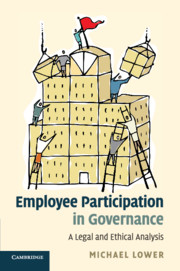Book contents
- Frontmatter
- Contents
- Acknowledgements
- Tables of legal instruments
- 1 Introduction
- 2 Catholic Social Thought: nature, sources and core principles and values
- 3 Catholic Social Thought and work
- 4 Catholic Social Thought, private property and markets
- 5 The corporation
- 6 The firm and society
- 7 Employee participation in corporate governance: an ethical analysis
- 8 Corporate Governance in the United Kingdom
- 9 Labour law and employee participation
- 10 Employee participation and EU corporate governance
- 11 Conclusion
- Bibliography
- Index
6 - The firm and society
Published online by Cambridge University Press: 05 October 2010
- Frontmatter
- Contents
- Acknowledgements
- Tables of legal instruments
- 1 Introduction
- 2 Catholic Social Thought: nature, sources and core principles and values
- 3 Catholic Social Thought and work
- 4 Catholic Social Thought, private property and markets
- 5 The corporation
- 6 The firm and society
- 7 Employee participation in corporate governance: an ethical analysis
- 8 Corporate Governance in the United Kingdom
- 9 Labour law and employee participation
- 10 Employee participation and EU corporate governance
- 11 Conclusion
- Bibliography
- Index
Summary
Introduction
The previous chapter looked at the corporation in a certain sense in isolation from other communities. The chapter was concerned to show that the corporation (like all communities) has a reality of its own. Thus, the firm has its own ability to act and it can continue in being regardless of any change in the composition of its members. Another important concern of the previous chapter was to show that the firm is at the service of certain specialised aspects of the flourishing of its members. The firm enables its members (employees and shareholders) to pursue certain of their goals in collaboration with each other. By working together in the firm, its members can get more out of their work and their investment than they could achieve in isolation. Thus, the firm and its common good can only be understood and evaluated by considering how well it facilitates the flourishing of their members. The perspective provided in the previous chapter has now to be filled out by considering how the firm relates to the broader economy and to society at large. The previous chapter looked inward by asking about the relationship between the firm and its members. This chapter looks outward and places the firm into a broader social fabric.
Society
The previous chapter explained that a group, society or community could be said to exist when two or more individuals agree to co-ordinate their activity for the sake of achieving some common purpose.
- Type
- Chapter
- Information
- Employee Participation in GovernanceA Legal and Ethical Analysis, pp. 79 - 91Publisher: Cambridge University PressPrint publication year: 2010

